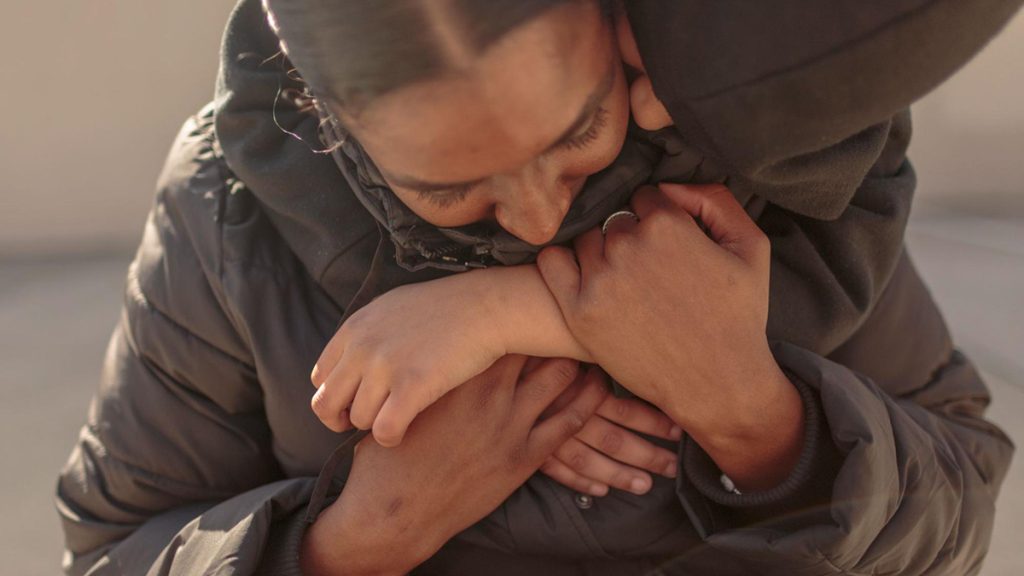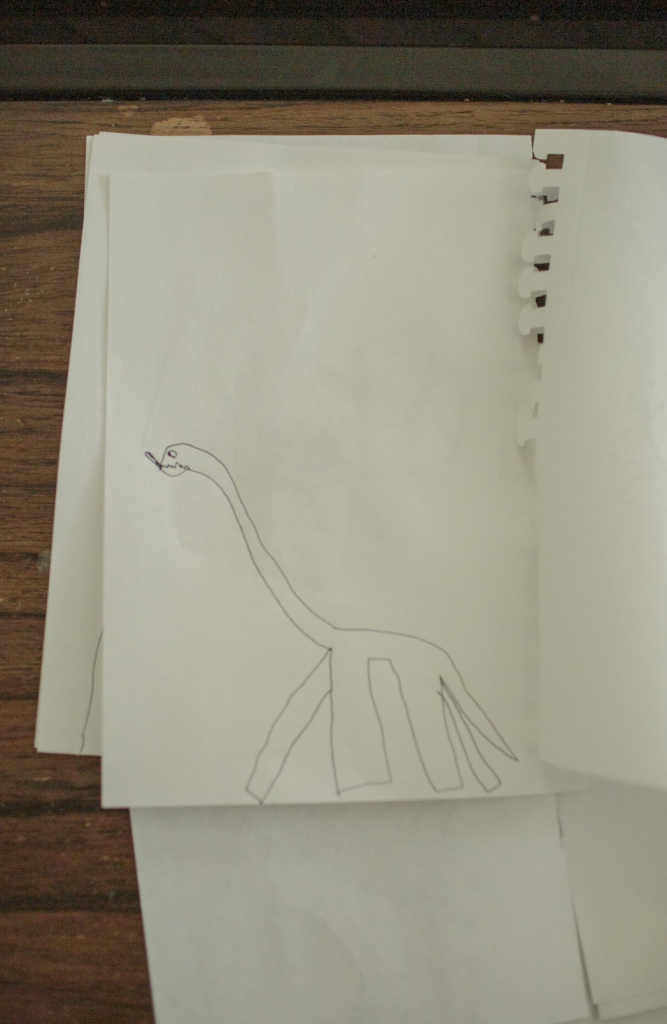
Blanco and Ian. Photo: Sarah Blesener | ProPublica
Before entering a space
Insights from the other side of the lens
What helped prepare you to feel safe and ready to meet with the reporter?
E: The phone call was impactful because it just felt so personal. It was a conversation. It’s not so complex, but it led me to having some knowledge around the structure of the interview, what the questions were, what the experience would be like, and if I had any questions myself. This gave me space to then ask a question and to respond. It wasn’t just one sided – I felt involved. I felt like I understood what I was agreeing to. I knew what to expect. I knew how to prepare mentally and emotionally.
Safety is in the details
Judith Herman outlines in her book Trauma and Recovery how important establishing safety is for trauma survivors. “Trauma robs the victim of a sense of power and control; the guiding principle of recovery is to restore power and control to the survivor. The first priority is to establish the participant’s safety.

Collaboration and sharing decision making occurs in the small decisions, gestures and tone set: transparency about who we are, what we are doing, asking the participant to choose the time (and time limit) and showing up on time, the participant having control of the environment and who is there as a witness, not crossing agreed upon boundaries, and more.
Safety is also a shared responsibility, not just something that rests on the shoulders of the photojournalist in the field. It begins long before the assignment starts – in the conversations, planning, and support structures built within the newsroom itself.
Providing clear guidance, space for dialogue, and a well-thought-out plan before an assignment unfolds is 90% of the work for prioritizing the safety of everyone involved. That means more than just reviewing logistics; it means anticipating emotional risk, clarifying expectations, asking questions, understanding the context, and ensuring journalists have the tools,emotional, ethical, and material they need to navigate complex situations. This plan also includes a communal conversation around how to visually work with the specific individual, story and history you are meeting: how can we work against stereotypical visuals of this topic? What alternative ways of making visuals can we brainstorm together as a team?
At the heart of our work building resources for care-driven visual journalism, we interviewed over 40 individuals. The following interview responses are from participants, their names have been kept to first initial.
How did it feel having your photo taken?
H: It made me feel not human. In the moment that I was experiencing one of the deepest experiences emotionally in my life: I just lost someone close to me, I just witnessed their death. I was suffering so much. And then… to be seen….but not be seen…. rather to be observed. It felt dehumanizing. The photojournalist’s approach was so detached from the reality of what was really happening. In the 24-hour news cycle we have people rushing and getting stories out immediately, and my story just became something to sell on the news.
E: People in trauma respond to things very differently. They can interpret things in a way that you maybe did not intend. Trauma survivors are very observant – they pick up on body language, they pick up on facial expressions and body responses to conversations. The individual who photographed me didn’t have very big reactions. This made me feel like I could talk about whatever I wanted. He was listening, and allowed the conversation to develop naturally. He didn’t react – and that is what I mean. His body language stayed calm and open.
How could the approach have been different in ways that would have made this experience better?
H: I think I would have wanted to have been photographed honestly and on my own terms. Even the act of someone just asking consent is a huge step, and that results in me feeling like I am given something versus someone just taking it. If they’d have asked me, they’d have known that I would have liked to be photographed in a private situation. You know, maybe I don’t immediately want to experience a core trauma memory in public. I could have been more open if it was more on my own terms. It’s really just the small things: letting me pick the time, letting me have a choice in the date, giving me the option to meet somewhere private.
A: I wish the journalist would have explained to us the process. We aren’t in the media. We have never done this. We don’t know how this works. If we interview for hours, and recount our abuse and highly personal, traumatic experiences, and in the end, only a sentence is used, or only one image or even none were used, it feels shocking. Why could that not have been explained to us, so we understood the possible outcomes? Listen, even if the consent process was as straightforward as: “Hey, an interview like this usually lasts a few hours. This is normal when dealing with sensitive stories like yours. But the end result will only be around a ten minute video at most, and some segments we use online may be two to three minutes long.” This would have given me some idea of what will happen, and how the process works. It would have helped me understand what to expect. I just wish that participants would have more access to how these stories are built and why. We are giving so much vulnerability here. Why keep us in the dark? I guess what I am saying is to try to remove the element of surprise by all means possible. We don’t need more surprises.
What guidance would you give to a reporter or a photographer who walks into a space and meets someone in a similar situation as you? What could that journalist do that was different from your experience?
H: It’s important to keep in mind that a person that is in a state of immediate grief, that’s not who the person is. The bandwidth of what you are able to handle in trauma is radically changed. That person is still just trying to even process or understand what happened. They have these huge feelings. My advice… it’s more about trying to be genuine, taking your mask down. If you are going to document, if you are going to have these conversations that are so deeply intimate to what this person is feeling, try to take whatever mask you have down. This exchange requires a level of mutual vulnerability, and a continual respect of people’s choices and comfort of limitation. Those conversations around consent do not need to end. Even being asked, “Does this feel okay?” while photographing, and affirming “Anytime you want to tap out, it’s okay” goes a long way. Slow down, and don’t push people. There’s no need.
Questions of care: Initial dialogue and informed consent
Before entering the space and engaging with a participant, it’s crucial to establish informed consent and boundaries. Start by opening up a dialogue. Introduce yourself, your background, and open up the space for any questions on their end. When working with individuals in trauma, we must work against the element of surprise, avoiding triggering feelings or loss of control. It is essential to not assume that the participant is aware of the editorial process of the organization you are working for
Discuss
- What the participant’s comfort is around showing/not showing their physical identity.
- What their preferences are regarding the location and their privacy.
- Whether or not they want a family member or a friend to be there during the session, or if they want any children, siblings or loved ones in the photos with them. If they do not have a support system available, ask if they’d like you to come with another colleague in case they feel more comfortable with a third party on site.
- Set a time limit for your upcoming meeting. It is helpful to explain how long a typical photography session lasts to help manage expectations, and be flexible to work with their comfort.
- Ask the participant if they have any questions, and also if they have any ideas or areas they would like you to know more about before meeting.
- Remind participants to communicate throughout the session if they would like to take a break or stop. The aim here is to look at consent as ongoing versus a one-time agreement.
- This also means that the participant has the agency to change their mind at any moment. Individuals may not always understand the permanence of having their images and stories published on the Internet, or the unintended consequences that come from having their stories be public.
- Explain the editorial process (how many questions you typically ask, how many photos you take vs how many you use in the end, if there is a chance for their quotes or story to be cut, when they should expect publication, etc) as best as you can, and ask if they have any questions around your upcoming meeting.
Free training series
CatchLight and the Committee to Protect Journalists are offering an upcoming, free online training series focused on safety guidance for visual journalists on September 17, 24, and October 2 2025 (space is limited). Learn more here.
Can’t join the workshops?
We still invite you to complete the Safety in Focus survey. Your insights into the safety challenges visual journalists face today will help shape our curriculum and contribute to broader learnings that can strengthen safety practices across the field.
Additional resources
- Committee to Protect Journalists Pre-assignment preparation safety manuals and guides
- Poynter Institute Covering Vulnerable Sources Webinar
- The TEND Toolkit: A Library of Resource for Helping Professionals
- The Trust Kit from Trusted News
- Journalism Source of Safety
Cite this article
Jacklin-Stratton, Jenny; and Blesener, Sarah (2025, Sept. 4). Before entering a space. Reynolds Journalism Institute. Retrieved from: https://rjionline.org/news/before-entering-a-space/


